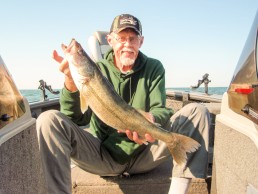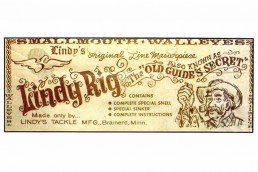The Lindy Rig Has Never Let Me Down
SHARE THIS POST
My adventures with the Lindy Rig began back in the 1970s at Pipestone Lake in northern Minnesota. A couple friends and I had journeyed from our homes in northwestern Ohio to spend a week in pursuit of the glamour fish of the northwoods, the golden-hued walleye.
I began casting and trolling the Original Rapala Floating Minnow, a usually reliable walleye killer in blue/silver and black/gold colors. After flailing the water with no success, my friend Al suggested that I switch to a Lindy Rig. My response? What the heck is it?
We made a quick trip to a local bait and tackle store, and under Al’s tutelage I picked up an assortment of floating jig heads, some ball bearing swivels and some sliding sinkers in 3/8- and 5/8-ounce, the basic components of the Lindy Rig.
I began fishing it, and my success increased exponentially. I caught both walleyes and northern pike and came home happy.
While I have never been back to Pipestone, I have successfully utilized the Lindy Rig in lakes in Ontario and Quebec, and most recently in Klotz Lake near Longlac, Ontario. It is very simple to assemble and very easy to fish.
Klotz lake is located off Highway 11 just 87 miles from White River, Ontario. Even though it is near a highway, the camp where my friends and I stayed, Flint Wilderness Resort, provides a true wilderness experience. Bear hunting is available in both spring and fall, there is a very good ruffed grouse population, plus there is always a chance of spotting a moose, lynx or wolf. As a matter of fact, the last time I was there, a lynx took a leisurely stroll through camp.
But we were there for the fishing, which proved to be pretty darned good.
Though we did throw a few artificial lures such as Rapala Floaters and Husky Jerks, nearly all our pike and walleyes fell to either the Lindy Rig or a bladed ‘crawler harness.
So, how to rig it? Begin with a floating Styrofoam jig head, in any color as long as it is pink/white. Other colors such as chartreuse or white will work, but day-in and day-out, pink/white is a killer color. My personal best at Klotz, a 9-1/4-pounder, bit on a pink/white jig. Choose a lead crooked sinker a.k.a. “walking sinker,” either 3/8- or 5/8-ounce for most situations, and thread it on your line through the back of the sinker, so that it will “walk” over rocks and other obstructions.
Tie on a small, matte black ball bearing swivel to keep your line from twisting. Then, tie to the other end of the swivel, attach a leader of about 2 to 3 feet in length. Tie your floating jig head to the leader and you have the basic Lindy rig.
Are you enjoying this post?
You can be among the first to get the latest info on where to go, what to use and how to use it!
Troll it behind your boat, at slow speed, at just enough distance that you can keep the line at a 45-degree angle, and so that your sinker occasionally ticks the bottom. When a fish bites, let out a little line so that the walleye can get the hook wholly in its mouth, take up the slack and set the hook.
Our last two trips to Klotz were very successful. In 2021, we hit the lake when it had hardly been fished for two years due to the Covid shutdown. The lake was on fire and we caught walleyes like crazy. Four of us estimated that we caught 300 “marble eyes” in about 4 1/2 days of fishing.
Six of us returned in 2022, and while we did not catch as many fish, we did quite well. The fish bit consistently all week. My personal best on that trip was a healthy 7-pounder which I froze and took home. My family and I enjoyed eating it.
Klotz is a big, long, sprawling lake with many islands and bays. It’s large enough that even when the camp is full, there still is enough water for everyone to fish his/her favorite spots without being crowded by other boats.
We had our best success by trolling in about 15 to 22 feet of water. Of course, we began by trolling whole nightcrawlers on our jigs, which is the standard means of fishing this rig. When the fish just nipped at the tails of the worms, we cut the ‘crawlers in two and just trolled half a worm. For about 98 percent of the time, this was the most successful tactic.
We were fishing in July when both the air and the water was warm, and the fish’s metabolism was in high gear. When they bit, there was little or no doubt that an active fish was on the hook. Some folks say that walleyes don’t put up much of a fight, but we found that a 4- or 5-pounder in about 18 feet of water on a spinning rod loaded with 6- or 8-pound test put up a darned good fight.
We brought them to the net, took them back to camp, filleted them in the comfortable, spacious fish house, rolled them in Zatarain’s fish breading, dipped them in the deep fryer and ate like kings.
So, thank you Al and Ron Lindner for inventing the Lindy Rig. I am returning to Klotz this July. I have every hope of doing well, and I know darned well that I will be using the good ol’ Lindy Rig.
For more info: Call Tim Simonis or Dave Stevens at 616.540.4329 or 616.262.6709. Or go online to www.flintwildernessresort.com.
MWO
SHARE THIS POST
Did you enjoy this post?
You can be among the first to get the latest info on where to go, what to use and how to use it!
John Bennett
John Bennett is a retired history teacher, historical re-enactor, father and grandfather. As a four-season outdoorsman, his passion is waterfowl hunting and fishing for smallmouth bass. He lives in Ohio and spends quite a bit of time in his primitive log cabin, which he built.



